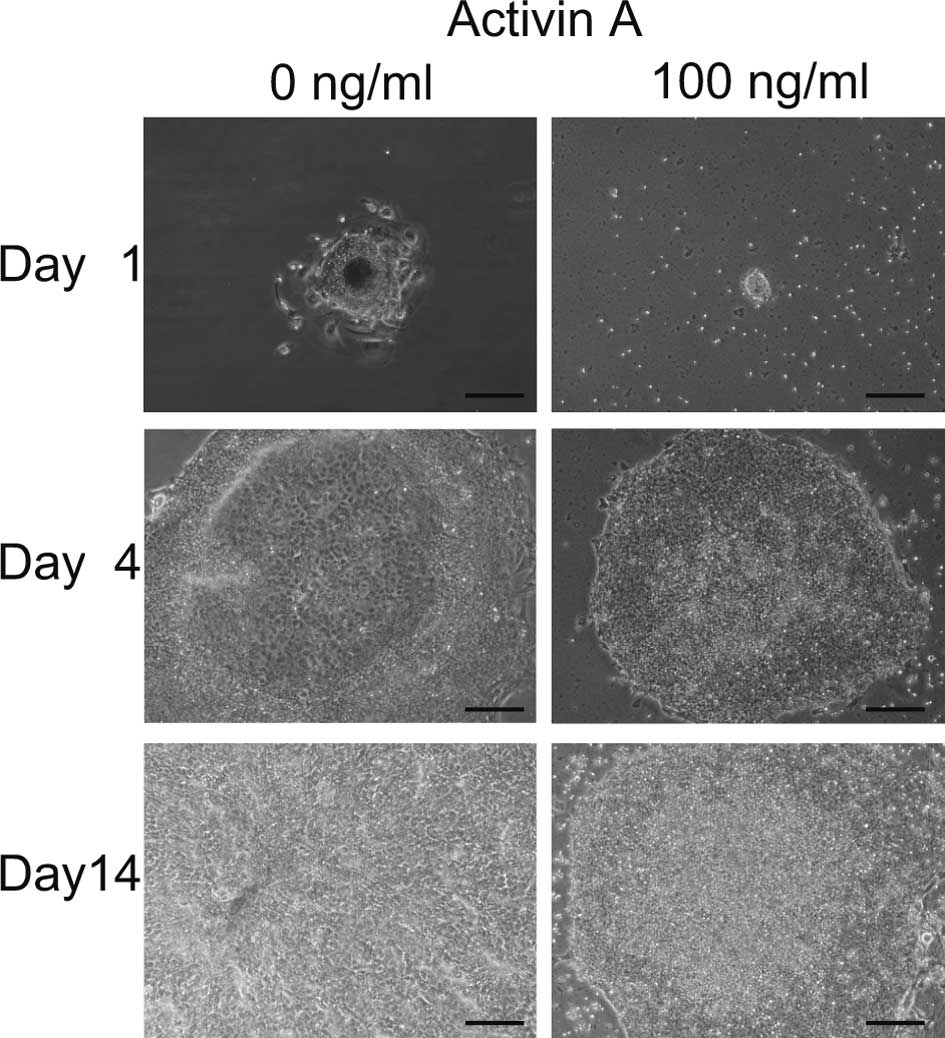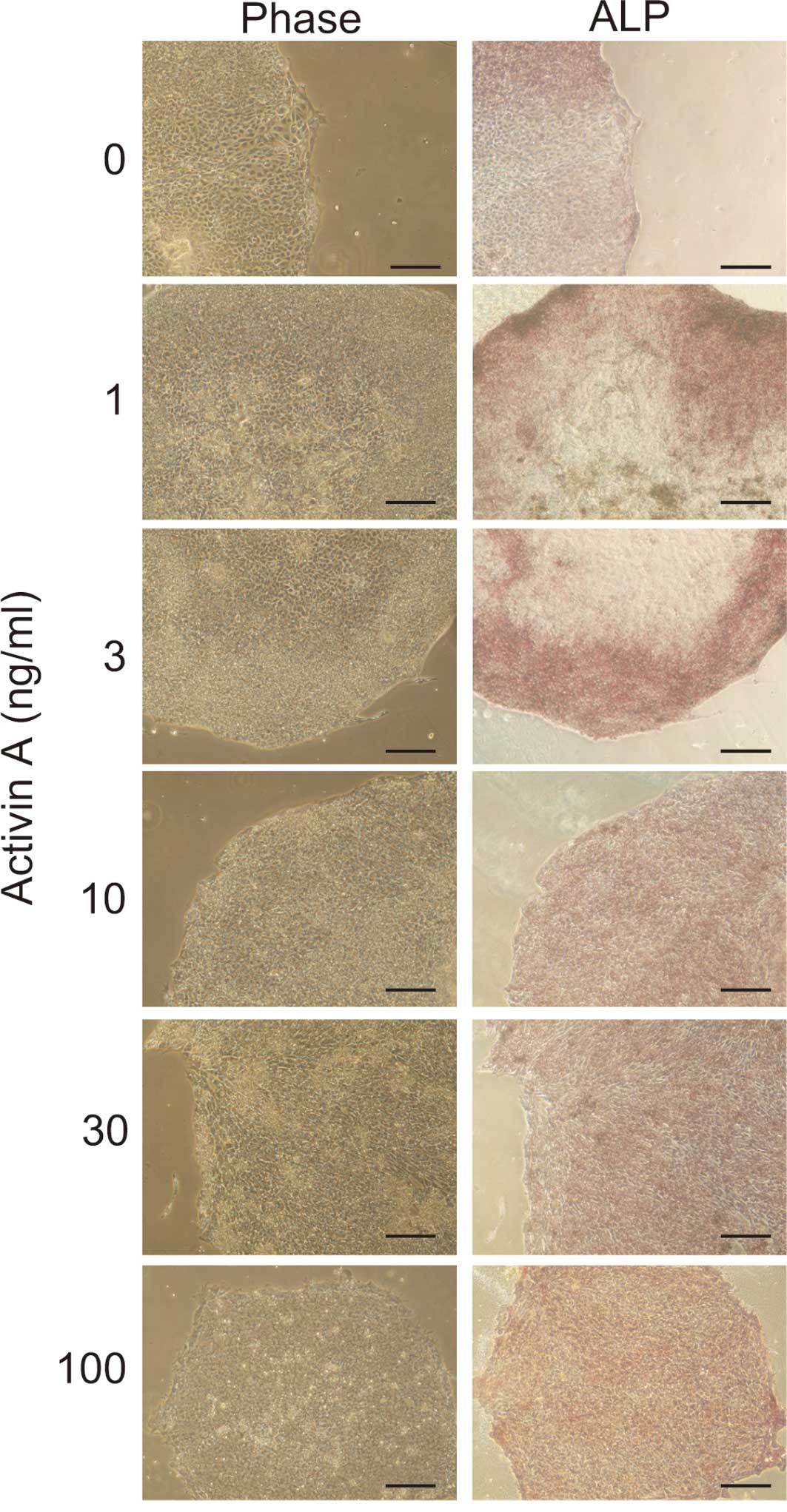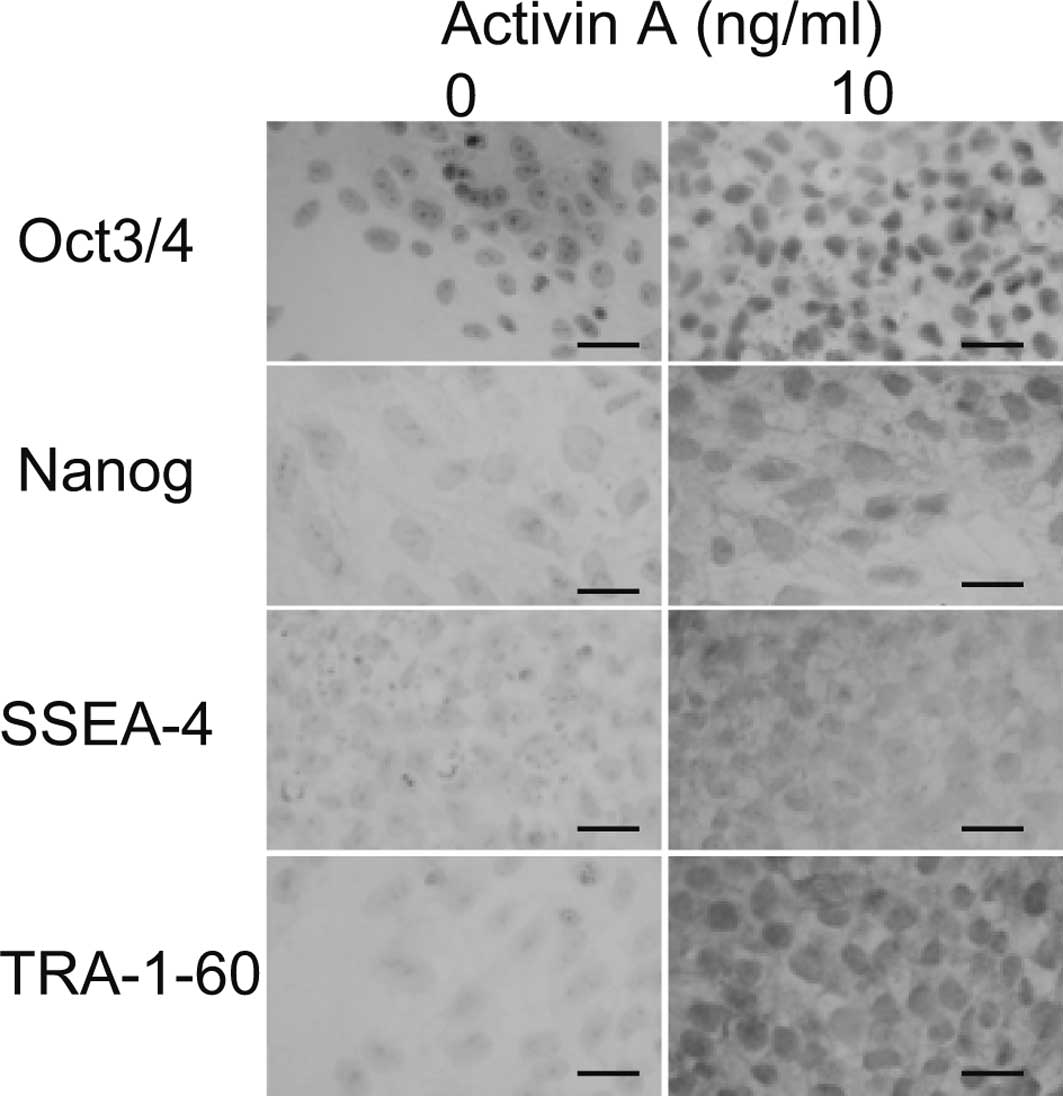Activin A maintains pluripotency markers and proliferative potential of human induced pluripotent stem cells
- Authors:
- Published online on: February 28, 2011 https://doi.org/10.3892/etm.2011.219
- Pages: 405-408
Abstract
Introduction
Activin A, a member of the transforming growth factor-β superfamily, mimics Nodal, binds Activin receptors and phosphorylates Smad2, thus activating it (1). Once activated, Smad2 associates with Smad4, translocates to the nucleus and regulates gene expression in conjuction with other transcription factors. Nodal/Activin A signals play a crucial role in inducing the development of the mesoderm and endoderm in the Xenopus embryo (2,3).
Activin A (100 ng/ml) promotes the differentiation of human embryonic stem (ES) cells into pancreatic β cells (4), and also into endoderm (5). By contrast, 5 ng/ml of Activin A was found to maintain self-renewal and to support the long-term feeder-free culture of human ES cells (6). However, it has not been fully established whether Activin A induces the differentiation of human ES cells into endoderm or maintains them in an undifferentiated state. Curiously, 100 ng/ml of Activin A, FGF-2 and BMP-4 was found to induce the expression of endoderm markers, while still maintaining pluripotency markers such as Oct3/4 and Nanog (7). These data suggest that a mixture of other growth factors or the specific concentration of Activin A may determine whether human ES cells differentiate or whether their pluripotency is maintained. To develop a feeder-free medium of human ES or induced pluripotent stem (iPS) cells, it is necessary to determine the appropriate concentration of Activin A.
Materials and methods
Cell culture and embryoid body formation
The human iPS cell line 201B7 (Riken Cell Bank, Tsukuba, Japan) was cultured in ReproFF media (Reprocell, Yokohama, Japan) for feeder-free culture (Reprocell, Tokyo, Japan) on dishes (Asahi Techno Glass, Funabashi, Japan) coated with Matrigel (Becton Dickinson, Franklin Lakes, NJ, USA) in 5% carbon dioxide at 37°C in a humidified chamber, and harvested with Accutase (Innovative Cell Technologies, Inc., San Diego, CA, USA) for subsequent experiments. Dissociated 201B7 cells were cultured in hanging drops at a density of 1,000 cells per 30 μl of medium composed of Dulbecco’s minimum essential medium-F12 medium (Sigma Aldrich Japan K.K., Tokyo, Japan) supplemented with 20% knockout serum replacement (KSR) (Invitrogen Japan K.K., Tokyo, Japan), 10% minimum essential amino acids (Invitrogen Japan K.K.), 2 mM L-glutamine (Invitrogen Japan K.K.) and 1 mM 2-mecaptoethanol (Sigma Aldrich Japan K.K.) [iPSm(-)] (8). After 4 days of hanging drop culture, the resulting embryoid bodies (EBs) were plated onto plastic dishes coated with Matrigel. Cells were observed under an Olympus IMT-2 microscope (Olympus, Tokyo, Japan).
Alkaline phosphatase staining
Alkaline phosphatase (ALP) staining was carried out in cells cultured on a 6-well plate (Asahi Techno Glass) coated with Matrigel. Alkaline phosphatase staining was performed with leukocyte alkaline phosphatase (Sigma Aldrich Japan K.K.) according to the manufacturer’s instructions.
Immunostaining
Cells cultured on 4-well chamber slides (Becton Dickinson) were fixed in 4% paraformaldehyde (Sigma Aldrich Japan K.K.) and incubated with hydrogen oxide in 100% methanol for 30 min at 4°C. Specimens were incubated with 2% fetal bovine serum in PBS (wash buffer) for 30 min at 4°C. For the anti-Oct3/4 (Becton Dickinson) and anti-Nanog (Reprocell) antibodies, specimens were incubated in 0.1% sodium citrate (Wako Pure Chemicals, Osaka, Japan) and 0.1% Triton X-100 (Wako Pure Chemicals) in distilled water. Diluted (1:500) anti-Oct3/4, anti-Nanog, anti-SSEA-4 and anti-TRA-1-60 antibodies (all from Nihon Millipore K.K., Tokyo, Japan) were incubated in wash buffer overnight at 4°C. After washing three times with PBS, diluted 1:500 horseradish peroxidase-labeled anti-mouse (GE Healthcare Japan, Tokyo, Japan) or anti-rabbit (GE Healthcare Japan) antibodies were incubated in wash buffer for 3 h at 4°C. Diaminobenzidine (Dako Japan, Tokyo, Japan) was applied, and the nuclei were stained with hematoxylin (Muto Pure Chemicals Co., Ltd., Tokyo, Japan) for 15 sec. Specimens were observed and photographed under an Olympus AX80 microscope (Olympus).
Cell proliferation assay
Cells were seeded onto a 96-well plate (Asahi Techno Glass) coated with Matrigel at a density of 1,000 cells/well. Twenty-four hours later, the medium was replaced with Activin A (R&D Systems Inc., Minneapolis, MN, USA). Seventy-two hours later, the 3-(4,5-dimethylthiazol-2-yl)-5-(3-carboxymethoxyphenyl)- 2-(4-sulfophenyl)-2H-tetrazolium inner salt (MTS) assay was performed according to the manufacturer’s instructions (Promega Corporation, Tokyo, Japan). MTS was bio-reduced by cells into a colored formazan product that reduces absorbance at 490 nm. The absorbance was analyzed at a wavelength of 490 nm with a Bio-Rad iMark microplate reader (Bio-Rad, Hercules, CA, USA).
Results
Initially, we aimed to promote the differentiation of iPS cells to hepatocytes with EB formation using 100 ng/ml of Activin A (9). Four days after the transfer of EBs to 6-well plates, differentiated cells appeared in the center of the colonies cultured with 0 ng/ml of Activin A, while no morphological change was noted in cells cultured with 100 ng/ml of Activin A (Fig. 1). Fourteen days later, all cells cultured with 0 ng/ml of Activin A were differentiated, while cells cultured with 100 ng/ml remained undifferentiated. These data indicate that Activin A maintained iPS cells in an undifferentiated state. It appeared that colonies grew more slowly when cultured with 100 ng/ml than with 0 ng/ml Activin A.
To determine whether the cells maintained an undifferentiated state after 14 days of culture in Activin A, ALP staining was performed. Cell cultured in >10 ng/ml of Activin A were positive for ALP staining (Fig. 2). In contrast, most of the cells cultured in <3 ng/ml of Activin A were negative for ALP staining. This suggests that 10 ng/ml of Activin A was sufficient to maintain the cells in an undifferentiated state.
To confirm that the cells remained undifferentiated at 10 ng/ml of Activin A, immunostaining was performed. All cells cultured in 10 ng/ml of Activin A demonstrated positive nuclear staining for Oct3/4 and Nanog (Fig. 3). None of the cells in the absence of Activin A were positive for Oct3/4 or Nanog. The cell surfaces of all of the cells cultured in 10 ng/ml Activin A were positive for SSEA-4 and TRA-1-60, while none were positive in the absence of Activin A. These results suggest that 10 ng/ml of Activin A maintains cells in an undifferentiated state.
Fig. 1 indicates that cells cultured with 100 ng/ml of Activin A exhibited weaker proliferation than those cultured in 0 ng/ml. The MTS assay was performed to analyze the effects of Activin A on the proliferative potential of the cells, and revealed a proliferation of >100% in cells cultured with 3–30 ng/ml of Activin A, and of 85.5% at 100 ng/ml, compared to cells treated with 0 ng/ml (Fig. 4). This demonstrated that Activin A promotes cell proliferation at a concentration of 3–30 ng/ml, while a concentration of 100 ng/ml suppresses cell proliferation.
Discussion
Activin A (10 ng/ml) and FGF2 (12 ng/ml) maintain the pluripotency of human iPS cells in a feeder-free condition (10). Cultured human iPS cells form teratoma when transplanted into the testis capsule of severe combined immunodeficientbeife mice after 20 passages. In our experiments, 100 ng/ml of Activin A alone was added to the medium, since our initial goal was to develop a method of differentiating human iPS cells to hepatocytes. Unexpectedly, the cultured cells via EBs showed no morphological changes after 14 days of EB formation. Beattie et al obtained similar results when culturing human ES cells (HSF6) in media with several cocktails of growth factors (11). They found that a combination of Activin A (50 ng/ml), nicotinamide (10 mM) and keratinocyte growth factor (50 ng/ml) was sufficient to preserve the pluripotency of human ES cells. Our data clearly indicate that Activin A alone is capable of maintaining pluripotency markers in human iPS cells, as evidenced by ALP staining and immunostaining. Previously, the proliferation of human ES cells was found to be reduced and the passage of cells was halted by Actin A (11). Xiao et al succeeded in the long-term feeder-free culture of human ES cells (H1) for a time period longer than 150 days and 20 passages with 5 ng/ml of Activin A (6). The differences in results between the two previous reports may be attributed to the cell lines and concentrations of Activin A used. In certain cell lines, activation of another pathway may be necessary, since the Wnt pathway preserves the pluripotency of human ES cells (12). Xiao et al applied a lower concentration of Activin A for a successful long-term passage. Our MTS assay showed that human iPS cells exhibited a weaker proliferative potential when cultured in 100 ng/ml of Activin A compared to 0 ng/ml. Moreover, 3–30 ng/ml of Activin A was suitable for human iPS cell proliferation compared to 0 ng/ml. Our data and previous reports suggest that a lower concentration of Activin A is appropriate for human ES and iPS cells to maintain not only pluripotency markers, but also proliferative potential.
Activin A (25 ng/ml) was found to increase the expression of Oct3/4 and Nanog in human ES cells with pluripotency when added in chemically defined medium (13). When the medium was deprived of Activin A, the expression of Nanog was down-regulated (14). These reports verify that Activin A controls the expression of Oct3/4 and Nanog to maintain pluripotency.
Sulzbacher et al hypothesized that the pluripotency or differentiation of cells is dependent and occurs in a concentration- and stage-dependent manner (1). Activin A (5–50 ng/ml) was applied to maintain the pluripotency of human ES and iPS cells alone or with other growth factors (6,10,11,15). In the present study, as in the study of Xiao et al, 5 and 10 ng/ml of Activin A, respectively, were applied as a sole growth factor to maintain pluripotency. These data suggest that a lower concentration of Activin A maintains the pluripotency of human ES or iPS cells. Conversely, human ES (H9) cells were found to differentiate with FGF2 or Activin A (10 ng/ml) alone after three passages, and a combination of Activin A + FGF2 or Nodal + FGF2 was found to be optimal for the long-term expression of pluripotency markers (15). One may speculate that H9 cells require FGF2 in addition to Activin A. Whether Activin A is enough to maintain pluripotency or requires other growth factors may depend on the cell line.
To induce mesoendodermal differentiation, the optimal combination was found to consist of BMP4 (10 ng/ml), FGF2 (20 ng/ml), LY294002 (10 μM) and a higher concentration of Activin A (100 ng/ml) (10). These data indicate that a combination of growth factors and a higher concentration of Activin A is necessary for human ES or iPS cells to differentiate. Notably, Activin A (100 ng/ml), FGF-2 and BMP-4 induce the expression of endoderm markers, while still maintaining pluripotency markers such as Oct3/4 and Nanog (7). This may explain our finding that 100 ng/ml of Activin A maintained pluripotency markers, while other researchers noted differentiation at this high concentration.
Our next study will carry out the passage and long-term culture of human iPS cells in Activin A while analyzing the undifferentiated state.
Acknowledgements
This study was supported in part by a Grant-in-Aid for the Encouragement of Scientists from the Japan Society for the Promotion of Science (JSPS) (no. 22931047). The authors thank Dr Masaki Takiguchi and Dr Katsuro Iwase for the technical assistance and fruitful discussions.
References
|
Sulzbacher S, Schroeder IS, Truong TT and Wobus AM: Activin A-induced differentiation of embryonic stem cells into endoderm and pancreatic progenitors – the influence of differentiation factors and culture conditions. Stem Cell Rev. 5:159–173. 2009. | |
|
Smith JC, Price BM, van Nimmen K and Huylebroeck D: Identification of a potent Xenopus mesoderm-inducing factor as a homologue of Activin A. Nature. 345:729–731. 1990. View Article : Google Scholar : PubMed/NCBI | |
|
Thomsen G, Woolf T, Whitman M, et al: Activins are expressed early in Xenopus embryogenesis and can induce axial mesoderm and anterior structures. Cell. 63:485–493. 1990. View Article : Google Scholar : PubMed/NCBI | |
|
D’Amour KA, Agulnick AD, Eliazer S, Kelly OG, Kroon E and Baetge EE: Efficient differentiation of human embryonic stem cells to definitive endoderm. Nat Biotechnol. 23:1534–1541. 2005. | |
|
Yao S, Chen S, Clark J, et al: Long-term self-renewal and directed differentiation of human embryonic stem cells in chemically defined conditions. Proc Natl Acad Sci USA. 103:6907–6912. 2006. View Article : Google Scholar : PubMed/NCBI | |
|
Xiao L, Yuan X and Sharkis SJ: Activin A maintains self-renewal and regulates fibroblast growth factor, Wnt, and bone morphogenic protein pathways in human embryonic stem cells. Stem Cells. 24:1476–1486. 2006. View Article : Google Scholar : PubMed/NCBI | |
|
Touboul T, Hannan NR, Corbineau S, et al: Generation of functional hepatocytes from human embryonic stem cells under chemically defined conditions that recapitulate liver development. Hepatology. 51:1754–1765. 2010. View Article : Google Scholar : PubMed/NCBI | |
|
Tomizawa M, Toyama Y, Ito C, et al: Hepatoblast-like cells enriched from mouse embryonic stem cells in medium without glucose, pyruvate, arginine, and tyrosine. Cell Tissue Res. 333:17–27. 2008. View Article : Google Scholar : PubMed/NCBI | |
|
Basma H, Soto-Gutierrez A, Yannam GR, et al: Differentiation and transplantation of human embryonic stem cell-derived hepatocytes. Gastroenterology. 136:990–999. 2009. View Article : Google Scholar : PubMed/NCBI | |
|
Vallier L, Touboul T, Brown S, et al: Signaling pathways controlling pluripotency and early cell fate decisions of human induced pluripotent stem cells. Stem Cells. 27:2655–2666. 2009. View Article : Google Scholar : PubMed/NCBI | |
|
Beattie GM, Lopez AD, Bucay N, et al: Activin A maintains pluripotency of human embryonic stem cells in the absence of feeder layers. Stem Cells. 23:489–495. 2005. View Article : Google Scholar : PubMed/NCBI | |
|
Sato N, Meijer L, Skaltsounis L, Greengard P and Hemmati-Brivanlou A: Maintenance of pluripotency in human and mouse embryonic stem cells through activation of Wnt signaling by a pharmacological GSK-3-specific inhibitor. Nat Med. 10:55–63. 2004. View Article : Google Scholar : PubMed/NCBI | |
|
James D, Levine AJ, Besser D and Hemmati-Brivanlou A: TGFbeta/activin/nodal signaling is necessary for the maintenance of pluripotency in human embryonic stem cells. Development. 132:1273–1282. 2005. View Article : Google Scholar : PubMed/NCBI | |
|
Vallier L, Mendjan S, Brown S, et al: Activin/Nodal signalling maintains pluripotency by controlling Nanog expression. Development. 136:1339–1349. 2009. View Article : Google Scholar : PubMed/NCBI | |
|
Vallier L, Alexander M and Pedersen RA: Activin/Nodal and FGF pathways cooperate to maintain pluripotency of human embryonic stem cells. J Cell Sci. 118:4495–4509. 2005. View Article : Google Scholar : PubMed/NCBI |













